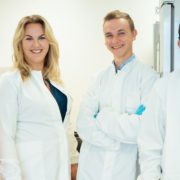International collaboration to strengthen the development of ATMPs
Skåne University Hospital, Lund University and Leiden University Medical Center (LUMC) will collaborate to develop research, education and development in the field of ATMPs (Advanced Therapy Medicinal Products). That is the essence of a Memorandum of Understanding that was signed at the SciLifeLab near Stockholm on Wednesday 12 October, during the state visit of the Dutch Royal couple in Sweden. The Swedish Minister for Education Anna Ekström and Dutch Minister for Education, Culture and Science Prof. Robbert Dijkgraaf attended the signing.

Picture by: Chris Jonker, Copyright: Ministry of Foreign Affairs
Advanced Therapy Medicinal Products
During the recent decade, scientific breakthroughs in cell biology and genetics have enabled development of new treatments called Advanced Therapy Medicinal Products (ATMPs). ATMPs are innovative and complex biological drugs based on cells, tissues or genes that offer new ground-breaking opportunities for treatment of a variety of disease, such as various forms of cancer, Parkinson’s disease and genetic blood disorders.
Collaboration between Leiden and Lund
Healthcare and academy in both Lund and Leiden are collaborating closely with important innovation environments and research infrastructure. In Leiden, among others the Leiden Bio Science Park and in Lund for example, Medicon Village, MAX IV and ESS – all located in Medicon Valley, one of Europe’s strongest life science clusters.
LUMC and Lund already cooperate within various networks, such as LERU. This enables, for example, student exchanges between the two organisations. Also, they are indirectly connected via common partners, like the University of Copenhagen with whom LUMC works together within reNEW. Thanks to the signing of the MoU, the cooperation between the two institutes is much further intensified.
The collaboration that is now underway is broad and covers areas such as research, exchange of researchers, education, clinical studies, development of therapeutic products, collaboration with industry and care delivery. The joint forces between Lund and Leiden has the potential to grow into one of the strongest international hubs for ATMP development, also because each region is already embedded in a broader network. With the signed memorandum, the process now enters a negotiation phase to agree on which activities the three parties will work on during coming years.
“Developing ATMPs is a high priority in many countries, also in Sweden. The collaboration with Leiden is an important step in a joint gathering of forces in the area. Within the field of ATMP, it is particularly important to link basic research to clinical treatment. Both Lund and Leiden have proven to be in the forefront in these areas”, says Erik Renström, Vice-chancellor of Lund University.
State of the art facilities
The Netherlands has a strong ATMP program incorporated in the Dutch Science Agenda route on regenerative medicine. The LUMC has a leading position in this field, with state of the art facilities. In 2022 it established a 4,000 m2 GMP facility for manufacturing and process development of cell and gene therapies called, NecstGen. Regenerative medicine is one of the main research themes in Leiden. Prof. Pancras Hogendoorn, dean LUMC: ”By building strategic collaborations both nationally and internationally we can combine necessary disease-specific expertise, capacity for innovative research and we create access to more donor and patient material. “
Future development
At Skåne University Hospital in Lund a top modern ATMP centre is under construction and will be established in 2024. Nationally, Lund University is one of the leading universities regarding research in cell, tissue and gene therapy. ”This collaboration is important for the future development of ATMPs. It means that we will get greater opportunities to offer ATMP treatments to seriously ill patients.”, says Björn Ekmehag, Chief Executive Officer at Skåne University Hospital.
Unlike classical medicines, which are usually developed entirely within the pharmaceutical industry, the majority of ATMPs are developed using academic innovation as a starting point. Many ATMP products also rely on healthcare providers as a link in the development process. Bringing these new therapies to patients requires collaboration and coordination between leading academic and clinical centres.











